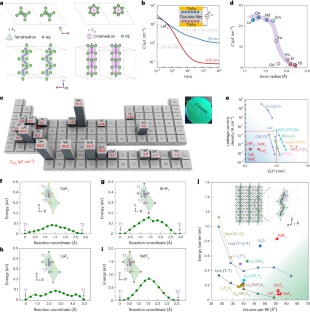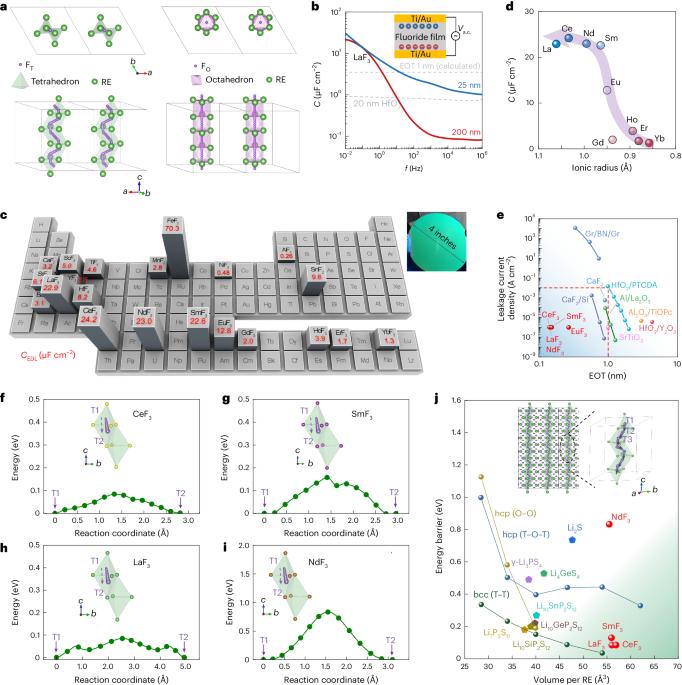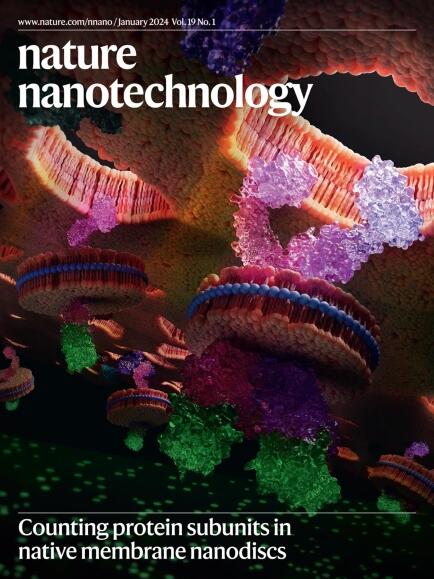Superionic fluoride gate dielectrics with low diffusion barrier for two-dimensional electronics
IF 34.9
1区 材料科学
Q1 MATERIALS SCIENCE, MULTIDISCIPLINARY
引用次数: 0
Abstract
Exploration of new dielectrics with a large capacitive coupling is an essential topic in modern electronics when conventional dielectrics suffer from the leakage issue near the breakdown limit. Here, to address this looming challenge, we demonstrate that rare-earth metal fluorides with extremely low ion migration barriers can generally exhibit an excellent capacitive coupling over 20 μF cm−2 (with an equivalent oxide thickness of ~0.15 nm and a large effective dielectric constant near 30) and great compatibility with scalable device manufacturing processes. Such a static dielectric capability of superionic fluorides is exemplified by MoS2 transistors exhibiting high on/off current ratios over 108, ultralow subthreshold swing of 65 mV dec−1 and ultralow leakage current density of ~10−6 A cm−2. Therefore, the fluoride-gated logic inverters can achieve notably higher static voltage gain values (surpassing ~167) compared with a conventional dielectric. Furthermore, the application of fluoride gating enables the demonstration of NAND, NOR, AND and OR logic circuits with low static energy consumption. In particular, the superconductor–insulator transition at the clean-limit Bi2Sr2CaCu2O8+δ can also be realized through fluoride gating. Our findings highlight fluoride dielectrics as a pioneering platform for advanced electronic applications and for tailoring emergent electronic states in condensed matter. Superionic fluoride dielectrics with a low ion migration barrier are capable of excellent capacitive coupling and are highly compatible with scalable device manufacturing processes for integrated electronics.


用于二维电子器件的低扩散阻抗超离子氟化物栅极电介质
当传统电介质在击穿极限附近出现漏电问题时,探索具有大电容耦合的新型电介质是现代电子技术的一个重要课题。为了应对这一迫在眉睫的挑战,我们在此证明了具有极低离子迁移势垒的稀土金属氟化物通常可以表现出超过 20 μF cm-2 的出色电容耦合(等效氧化物厚度约为 0.15 nm,有效介电常数接近 30),并且与可扩展的器件制造工艺具有很好的兼容性。超离子氟化物的这种静态介电能力体现在 MoS2 晶体管上,它具有超过 108 的高导通/关断电流比、65 mV dec-1 的超低亚阈值摆幅和 ~10-6 A cm-2 的超低漏电流密度。因此,与传统电介质相比,氟化物门控逻辑反相器可实现更高的静态电压增益值(超过 ~167)。此外,应用氟化物门控技术还能演示低静态能耗的 NAND、NOR、AND 和 OR 逻辑电路。特别是,通过氟化物栅极还可以实现清洁极限 Bi2Sr2CaCu2O8+δ 的超导体-绝缘体转变。我们的研究结果凸显了氟化物电介质是先进电子应用和定制凝聚态中出现的电子状态的先驱平台。
本文章由计算机程序翻译,如有差异,请以英文原文为准。
求助全文
约1分钟内获得全文
求助全文
来源期刊

Nature nanotechnology
工程技术-材料科学:综合
CiteScore
59.70
自引率
0.80%
发文量
196
审稿时长
4-8 weeks
期刊介绍:
Nature Nanotechnology is a prestigious journal that publishes high-quality papers in various areas of nanoscience and nanotechnology. The journal focuses on the design, characterization, and production of structures, devices, and systems that manipulate and control materials at atomic, molecular, and macromolecular scales. It encompasses both bottom-up and top-down approaches, as well as their combinations.
Furthermore, Nature Nanotechnology fosters the exchange of ideas among researchers from diverse disciplines such as chemistry, physics, material science, biomedical research, engineering, and more. It promotes collaboration at the forefront of this multidisciplinary field. The journal covers a wide range of topics, from fundamental research in physics, chemistry, and biology, including computational work and simulations, to the development of innovative devices and technologies for various industrial sectors such as information technology, medicine, manufacturing, high-performance materials, energy, and environmental technologies. It includes coverage of organic, inorganic, and hybrid materials.
 求助内容:
求助内容: 应助结果提醒方式:
应助结果提醒方式:


